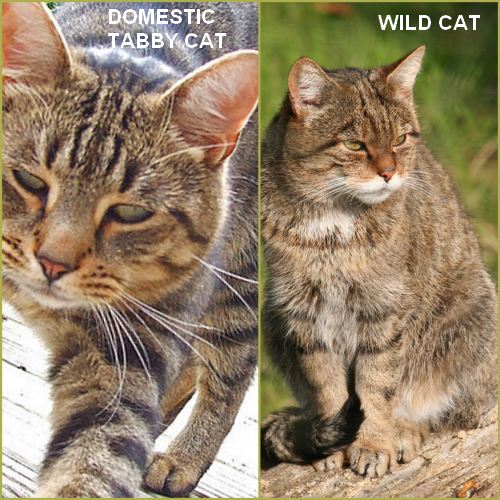The domestic cat is the same as the North African wildcat in terms of genetics; they both have 19 pairs of chromosomes (38 total). Therefore the domestic and wildcat can mate and produce fertile hybrids. But there are major fertility differences between these cats. Both are seasonal breeders but whereas the female wildcat has one estrus cycle occurring in January or February, domestic cats of the Northern Hemisphere have multiple estrus cycles during spring, summer and during most of the autumn months. They are seasonally polyestrus.

Whereas the female wildcat produces a single litter of kittens annually, the domestic cat can produce two or three. It depends on how long her kittens remain with her before being weaned. This makes the domestic cat very fertile which is a source annoyance to people who either don’t like domestic cats or are upset by domestic cat predation of native species and/or a large feral cat population.
The second major difference between these species of cat is that the domestic cat remains more juvenile in his/her behaviour traits than the wildcat. Juvenile behaviour traits of the domestic cat persist into adulthood. This is called “neoteny”.
The domestic cat is more accepting of and sometimes desires associations with other cats and with their human caretakers. They form attachments whereas the wildcat’s family unit breaks up once the juvenile has reached puberty and each cat lives a relatively solitary life during adulthood.
The wildcat interacts with other cats on two occasions: mating and during territorial disputes. Behaviors such as mutual grooming, play and “care soliciting” are not present in adult wildcat behaviour but it is seen in cubs. We all know that adult domestic cats seek play, petting and affection from their human caretakers. They form bonds with humans, other cats and other animals.
The reason for this perpetual state of juvenile behaviour is because the human/domestic cat relationship keeps the cat in that state. The classic juvenile behaviour is kneading us. They are reverting to kittenhood trying to stimulate a milk supply. Many domestic cat behaviours are related to the fact that the domestic cat remains a kitten in his behaviour towards his human caretaker – a “pseudo-parent”.

Very interesting and enlightening to know that the northern wildcats are polyestrus and not the domestic which has their estrus cycles in January and February.I did own a cat that had been fathered by a true wild cat breed. I wonder if he was destined to roam more than he did ; had he not been neutered?
I know males do not have menstrual cycles-but could he have been a secret Don Juan in disguise.Eva
I love articles of yours like this (and you provide so many of them too!), that so clearly reveal that you don’t even have the education level of a 10-year-old. Lots of species, from insects to reef-life to birds, even some plants, have 19-pairs of chromosomes. By your reasoning they can all mate to produce viable offspring. Tell me, are the horse and donkey the same species? They can mate and reproduce. Note: that is a question usually reserved for 3rd-graders in grammar-school. There is a question-challenge TV show in the USA called “Are You Smarter Than a 5th-Grader?” They’d have to change that to “3rd-Grader” for the one you appeared on.
ROFLMAO!!!
Perhaps you should stick to articles for which you are personally educated. Like … Oh, I don’t know … how to let a cat hump your arm and then tell the world how much you like it and that there’s nothing wrong with bestiality while all your site-members agree with you. ROFLMAO!!
So sick of you, Jim.
Reef birds, as well as any other birds, have no mentality at all. They’re too stupid not to place themselves in harms way, whether it be from a cat, snake, or a human.
It seems that you are as much a protector of birds as we are cats.
Why don’t you spend your time finding a way to expand the pea brains of birds rather than hanging out here?
Be productive.